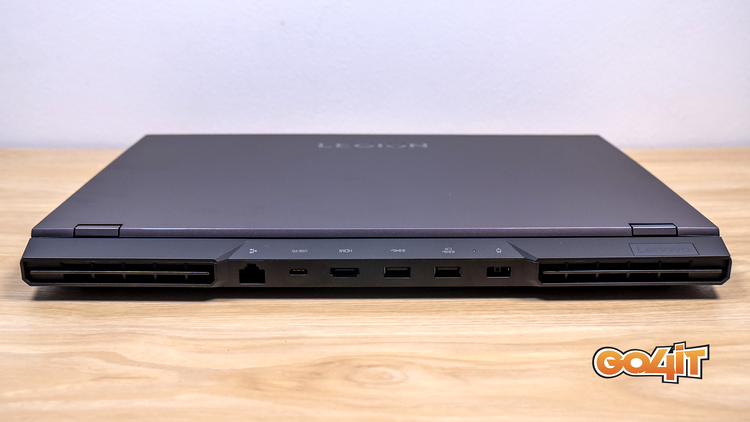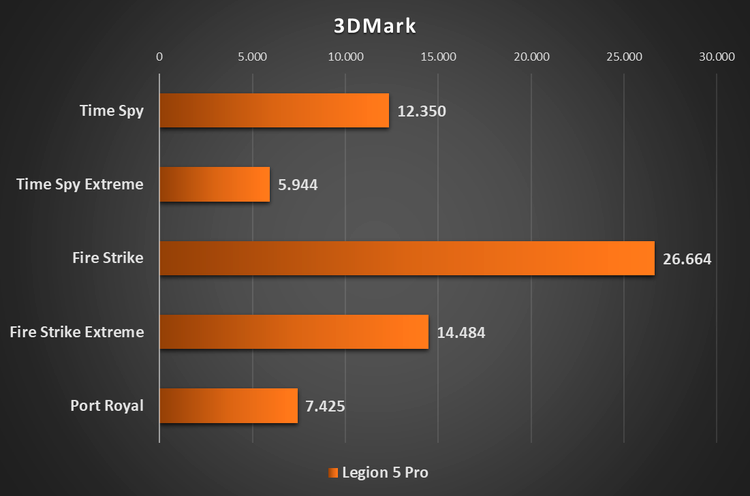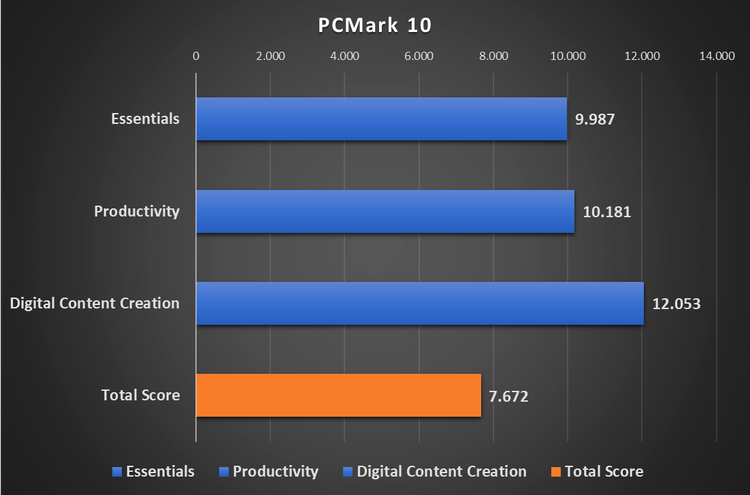Lenovo entered the gaming market late with the Legion series, but has proven its expertise in the PC market, managing to offer competitive products both in terms of performance and price. The Lenovo Legion 5 Pro proves that you can also deliver a high-performance laptop around the €2,000 price point that can take just about any game to very high detail. It also helps that we’re not talking about a compact laptop, but one with plenty of room for performance cooling as well as a large screen.
Legion 5 Pro isn’t “stuffed” with RGB lights everywhere
Like other laptops in its range, the Lenovo Legion 5 Pro benefits from a predominantly metal construction. The screen cover with the Legion logo is metallic, as is the area around the keys. The rest of the finish is plastic, but this is necessary to ensure light weight. At 2.49 kg, this laptop isn’t exactly “light”, but for the integrated hardware I can put that at average weight and size.
The display is a 16″ IPS panel, with very thin bezels all around and even a webcam integrated into the top. In order to make this possible, Lenovo has turned to the idea of “anti-notch”, i.e. extending the top edge of the screen into the camera area a bit. But this solution proves to be practical in another way too: it provides a comfortable area to grip the screen with your finger when you want to pick it up.
The laptop’s construction is solid, and it’s well put together. Basically, it “doesn’t knock, doesn’t thud”, and is exactly what I would expect from a computer in the €2,000 area. There’s plenty of room to integrate a keyboard with full numpad, even if it’s a little forced in there. The arrows go down a row for easy gaming use, unlike those on ultrabooks, which are usually small and cramped in the space between the CTRL and numpad. The shape of the keys is a common one for Lenovo computers, and they have a fairly long and satisfying travel for gaming as well as typing.
However, I’ve gotten used to the keyboard on a laptop being a bit more “centered” and without the numpad, so there is some time to adjust to this format. Likewise the trackpad, it’s moved a little to the left to sit in the space key area. Not infrequently I’d try to press it and realize there was nothing there. I would have preferred a larger trackpad. However, this being a gaming computer, it is here in a secondary role, as the expectation is that you will use it alongside a mouse.
On the connectivity side I have to admit I’m almost totally satisfied. Lenovo has been offering ports on the back of the computer for a few years now, but also puts a few on the side for extra convenience in use. On the back we have the important ports, such as the power port (still proprietary), two USB Type-A SuperSpeed ports, an HDMI and a USB-c with Power Delivery, suggesting it can be powered from this port. Presumably though, you can only power the battery, not the rest of the components to run at full power.
On the left side we have two USB-C ports, and on the right another USB-A 2.0, presumably for a mouse, or a wireless adapter. Also on the right we have a 3.5mm jack and a physical “privacy” button. It hardware shuts down the webcam and will certainly be appreciated. If you need the camera, you can turn it on right away.
It’s hard for me to understand why gaming laptop manufacturers don’t include an SD card slot, as these are often used by professionals who need both a high-performance computer for gaming and one for productivity. Manufacturing companies have “professional” computers on offer, with calibrated screens and “studio” graphics cards and card slots, but those don’t have screens as fast and seem to be built for a single use case.
Another annoying thing about the Lenovo Legion 5 Pro would be the socket adapter. It’s a bit thinner than others of its kind, but it’s still large and heavy. It’s understandable that a 300W 20V socket adapter is going to be big, and all that power is needed to power the computer at full load, but more compact solutions have emerged, such as GaN socket adapters, which reduce the size considerably.
The configuration is a top one for a 2022 laptop
We had the Lenovo Legion 5 Pro to test in a “near” top-of-the-line configuration. I say almost, because there are several other configuration options that would make this computer significantly more expensive. In this case, we have a 16″ display with QHD resolution at 165 Hz with G-SYNC, along with an Intel Core i7-12700H processor, 32 GB of RAM and an NVIDIA GeForce RTX 3070 Ti GPU.
The only ways you could improve this model would be the Core i9-12900HX processor option and the addition of a larger SSD. The 1TB used on this model is a very fast one, but after installing a few games it might not seem that roomy. The SSD can be upgraded after purchase though, as this is an M.2 2280 SSD model.
A GPU like the RTX 3070 Ti is probably all you ever need on a gaming laptop. Sure, there’s the RTX 3080 and RTX 3080 Ti, but those are usually built into much more expensive and larger computers, already entering the desktop replacement zone.
Legion 5 Pro’s display is big, high-resolution and fast
The Legion 5 Pro’s display is one of the high-quality, large diagonal 16:10 format displays with QHD resolution. This resolution is just right for the RTX 3070 Ti, as the hardware is more than capable of running most games in this resolution, even at very high detail and even with very advanced effects like ray-tracing.
The IPS panel is compatible with the VESA HDR400 standard and even Dolby Vision, but the brightness is a bit low for HDR, and the lack of local dimming makes the HDR effect too weak to be worth using. Still, the 400 nits the screen can display is good enough for work and gaming in just about any lighting situation in an apartment or office. The screen is also matte, so reflections aren’t too much of an issue.
There are 360 Hz or higher screens on laptops, but 165 Hz seems to offer a good balance between fluidity and the hardware’s ability to drive games at near framerates. There’s no point in having a 300 Hz screen if the hardware isn’t capable of running games at high framerates as well. And here we’re talking mostly about AAA video games with advanced graphics and high requirements. For eSports games, you don’t need such powerful hardware.
Lenovo has created a computer that’s fun to use, not just for gaming
As I said originally, the keyboard takes a bit of getting used to, if you’re coming from a laptop that had the keys and trackpad rather centered on the body of the laptop. However, the settling in takes a little while, and the numpad is really useful. For example, during benchmarks, I appreciated its presence to enter test results from the numpad into Excel. Anyone who works with tables and does calculations often will appreciate the numpad. Strictly for gaming, I don’t think it has much utility.
The keyboard is also backlit, but it doesn’t have per-key illumination, only four-zone illumination. These can be configured with various effects, or static colors. Given this limitation, I recommend a single colour over the entire area. I’m glad, however, that Lenovo’s engineers were more reserved with the lighting and didn’t “clutter” this computer with other lights in areas where it wouldn’t make sense anyway, as we’ve kept seeing in recent years. The less RGB we see on computers, the better, I say.
Lenovo includes an app called Vantage, which has evolved quite a bit from previous years when it was quite limited. Even now it doesn’t offer a lot of options, but it at least has a friendlier interface, and you easily get to whatever option you need. From here you can set the desired performance level from three preset profiles: Quitet, with the lowest performance level but also low cooler noise, Balance Mode, which uses AI to calibrate performance levels, and Performance Mode, which also includes overclocking for GPU and VRAM. Of course, we did all our testing in Performance Mode with overclocked to maximum.
Also from Vantage, keyboard lighting is configured and monitor overdrive mode can be enabled for the shortest response time. Lenovo also offers a mux-switch that allows the laptop to run exclusively on the NVIDIA GPU for a performance boost. There’s also the option of dynamic switching via Optimus, but sometimes switching between iGPU and dGPU can affect performance. And driver and BIOS updates are also done from Vantage, and I even applied a BIOS update on the first run of the app to keep up with performance optimizations. Everything worked just fine.
However, I appreciated that even on the highest performance mode, the cooler doesn’t go crazy, as we’ve seen on other models. They still run in dynamic mode, but have a slightly more aggressive throttle curve. So in Windows and when you’re not doing much with the CPU or GPU, they don’t run consistently at high revs. In fact, even at full revs, they don’t make noise so loud that it bothers you very much. Sure, you hear them, even with sound from the speakers, but it’s a bearable sound. It’s impressive how far cooling has advanced on laptops, and that these components can now run at fairly high performance even at high temperatures.
At full load, the CPU jumps 90 degrees and the GPU gets around 86 degrees, but I didn’t feel that in gaming performance, which suggests Lenovo has set the throttling temperature pretty high. If I didn’t feel heat at the top of the keyboard, I wouldn’t even look at the chip temperatures. It remains to be seen how “healthy” it is to run at these temperatures in the long run, but if you want to extend the life of your components, you can always drop GPU overclocking and lower the performance profile. Even on the balanced profile, this computer will be more than capable of running all demanding games and creative applications at a very good performance level.
When it comes to battery life, we shouldn’t expect miracles. We’re still talking about a big-screen gaming laptop. You can “squeeze” 4-5 hours of light productivity with browsing and documents with the screen at half brightness and an economical power consumption profile. But that’s about it. There’s also no question of gaming on battery, as you could run out of battery in less than an hour, and performance would be limited anyway by lack of charger.
Performance is at about the highest level on a laptop today
All the other things like quality construction and a high-performance screen are “nice to have” on a gaming laptop, but they don’t even matter if performance is at a low level. Fortunately, the Lenovo 5 Pro manages to live up to expectations and even exceed them in places.
Gaming tests were conducted in both Full HD resolution and the laptop’s native QHD resolution. We used 16:9 resolutions because they’re easier to compare, for 16:10 resolutions, performance might drop a few percent, but there shouldn’t be a big difference. All games were run on the highest preset performance profiles (Very High/Ultra).
Gaming

3DMark
The only exceptions are Watch Dogs Legion and Metro Exodus. Watch Dogs Legion on Ultra requires more than the 8GB of video memory that the RTX 3070 Ti offers, and Metro’s Extreme profile is overkill, tweaking several settings to truly “extreme” levels. All tests with DLSS or FSR are done on the “balanced” setting, as it gives a good ratio between good image quality and increased performance. Rainbow Six Siege was put in a separate table because it has extraordinarily high framerates and made the rest of the bars too small in comparison.
PCMark
Benchmarks
Cinebench R23
- Single-Core: 1.810
- Multi-Core: 17.885
CrystalDiskMark SEQ1M Q8T1
- Read: 6.643 MB/s
- Write: 4.936 MB/s
CrystalDiskMark SEQ1M Q1T1
- Read: 4.541 MB/s
- Write: 4.347 MB/s
Synthetic tests show that the CPU and SSD are also at a higher performance level, with transfer speeds of over 6 GB and the ability to perform very complex tasks, especially in areas where multi-core performance is important, such as video editing.
For now, but also for the near and even medium future, this system should run any game or any complex application in the creative area without problems.
Conclusions
The Legion 5 Pro is a high-performance gaming laptop that stands out both for its simplicity in design, without too many RGB lights, but also for a mix of high-performance components in a well-assembled body. However, I can’t ignore the fact that these components will soon become “last generation”. And this could be an advantage.
We’re at the point where new hardware is about to be released in the laptop market, as just about every PC component has gone to a new generation this fall. We’ve got the new Intel Raptor Lake processors (13th generation), AMD Ryzen 7000 processors, NVIDIA RTX 40 graphics cards, and soon we’ll see the new AMD Radeon 7000 graphics cards. This means that very soon we will also see laptop versions of these components, and the market will once again be flooded with new laptops to replace those currently on offer in the shops.
As we are also in the sales season, with Black Friday behind us, and traditional holiday sales ahead, current generation computers will surely be on sale to make way for new models that will be announced in the near future. And even if they’re not significantly discounted now, they’ll certainly be cheaper in just a few months after the new variants are announced. Since the performance level is high, a Legion 5 Pro at a substantial discount offer could be a very good “catch”.














 What’s happening with AI? Researcher explains why you can look forward to more creative NPCs, competition for ChatGPT and hot dog tomatoes
What’s happening with AI? Researcher explains why you can look forward to more creative NPCs, competition for ChatGPT and hot dog tomatoes Cowboy launches new on-demand service: That’s what’s inside
Cowboy launches new on-demand service: That’s what’s inside The new 4K Fire TV stick is now brutally reduced and transforms your old television into a smart TV
The new 4K Fire TV stick is now brutally reduced and transforms your old television into a smart TV The best mouse I’ve ever had, convinces me for gaming, work and home office and is different than all its predecessors!
The best mouse I’ve ever had, convinces me for gaming, work and home office and is different than all its predecessors! The first smart glasses suitable for everyday use that you can buy
The first smart glasses suitable for everyday use that you can buy